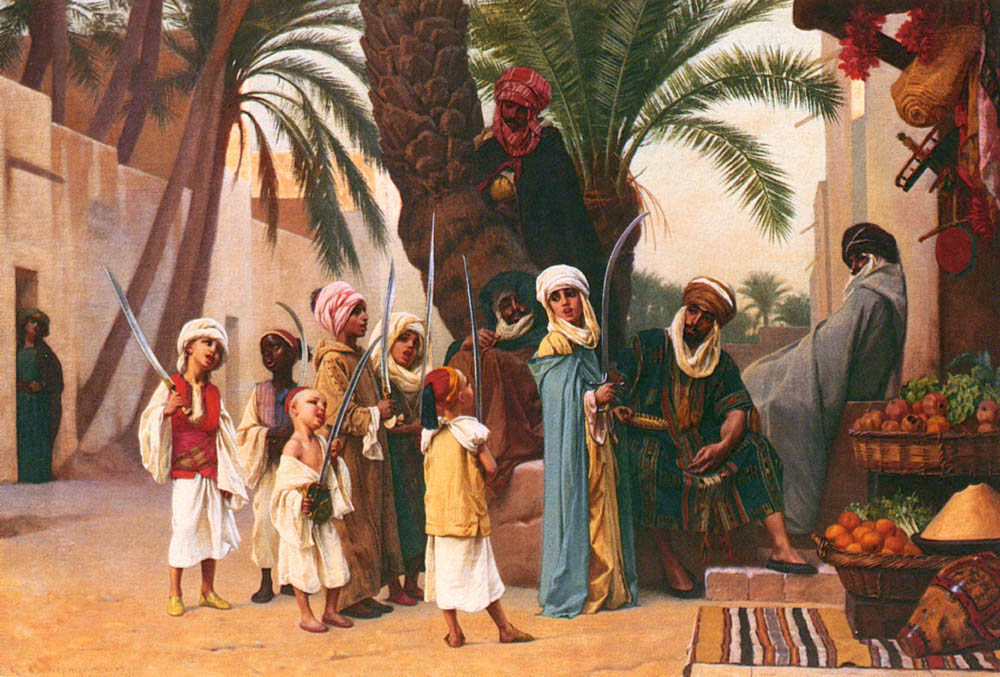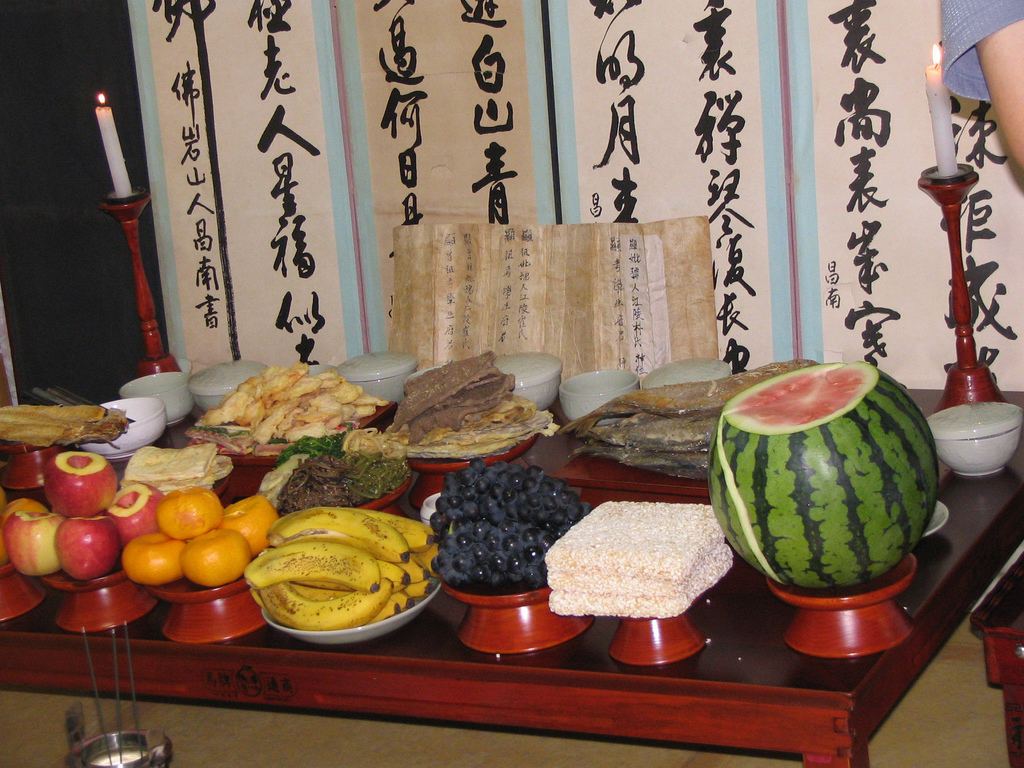|
Teojusin
Teojushin (Hangul: 터주신, Hanja: 터主神) is the patron of the ground on which the house is built in the Gashin cult of Korea. She is also known as Jishin, or 'earth goddess'. In Honam, there is no entity that resembles Teojushin. However, there is a deity called Cheollyungshin, the patron of Jangdok, or sauce containers. Compared with the worship of other Gashin, such as Jowangshin or Seongjushin, Teojushin is less known; still, she remains an important deity in Korean mythology. Worship Teojushin was believed to embody a pot holding rice, peas, or red beans. The pot was then buried or just placed on the corners of the backyard or the jangdokdae, an open area holding jangdok. The pot was covered with a cone-shaped umbrella woven of rice stalks. The grains within the pot was replaced every year, and the family made tteok, or rice cakes, out of them. The rice cakes were never shared; this is because the tteoks represented luck, and because of the belief that Teojushin was ... [...More Info...] [...Related Items...] OR: [Wikipedia] [Google] [Baidu] |
Gashin Cult
In Korean shamanism, Gasin (, literally ''House's God'') are a branch of deities believed to protect the various objects and rooms of the house, such as jangdok or the kitchen. The Gasin faith is the faith based on worshipping these deities. The worshipping of the Gasin form a central and integral part of the traditional Korean folk religion. Joryeong faith The faith of Joryeong is the deification of one's ancestors. The earliest mentions of the faith is in the ''Samguk Sagi'', a Medieval Korean history book, which mentions the 'golden chest' of Kim Alji, the first member of the Gyeongju Kim clan. This bears resemblance to modern ancestor worship. In the modern Honam region in southwest Korea, Koreans keep a large pot in the house, filled with rice. This is called the ''Jeseok Ogari'', and holds rice. The Jeseok Ogari is accompanied with ''Mom Ogari'', which are smaller potteries. The name of the ancestor or rice is put in the Mom Ogari. In the Yeongnam region, Jeseok Ogari a ... [...More Info...] [...Related Items...] OR: [Wikipedia] [Google] [Baidu] |
Jangdokdae
In Korean culture, Jangdokdae (Hangul: 장독대) or Jangttokttae is an outside space, most frequently a terrace, used to store or ferment food. Foods such as Kimchi, soybeans, grains, and bean and red pepper paste, are placed in '' Jangdok'' (or ''Onggi'') earthenware jars which are then placed on the ''Jangdokdae''. ''Jangdok'' (Hangul: 장독) means "crock" (for condiments and soy sauce) and ''dae'' (Hangul: 대) means "place", "support"... so ''jangdokdae'' (Hangul: 장독대) means "place for jangdok(s)". The jars are called ''hangari'' (Hangul: 항아리) or ''onggi'' (Hangul: 옹기). This place is commonly found directly near traditional Korean houses, more precisely near the kitchen. Sunshine and ventilation are key aspects in the location choice, so that foods can be preserved and kept fresh. Well-preserved ingredients may stay for several years in the jars. The similar terraces of royal palaces were called ''yeomgo'' (염고) and were supervised by a court lady, cal ... [...More Info...] [...Related Items...] OR: [Wikipedia] [Google] [Baidu] |
Hangul
The Korean alphabet, known as Hangul, . Hangul may also be written as following South Korea's standard Romanization. ( ) in South Korea and Chosŏn'gŭl in North Korea, is the modern official writing system for the Korean language. The letters for the five basic consonants reflect the shape of the speech organs used to pronounce them, and they are systematically modified to indicate phonetic features; similarly, the vowel letters are systematically modified for related sounds, making Hangul a featural writing system. It has been described as a syllabic alphabet as it combines the features of alphabetic and syllabic writing systems, although it is not necessarily an abugida. Hangul was created in 1443 CE by King Sejong the Great in an attempt to increase literacy by serving as a complement (or alternative) to the logographic Sino-Korean '' Hanja'', which had been used by Koreans as its primary script to write the Korean language since as early as the Gojoseon p ... [...More Info...] [...Related Items...] OR: [Wikipedia] [Google] [Baidu] |
Scimitar
A scimitar ( or ) is a single-edged sword with a convex curved blade associated with Middle Eastern, South Asian, or North African cultures. A European term, ''scimitar'' does not refer to one specific sword type, but an assortment of different Eastern curved swords inspired by types introduced to the Middle East by Central Asian ghilmans. These swords include the Persian shamshir (the origin of the word scimitar), the Arab saif, the Indian talwar, the North African nimcha, and the Turkish kilij. All such swords are originally derived from earlier curved swords developed in Turkic Central Asia (Turkestan). Etymology The English term ''scimitar'' is attested from the mid-16th century and derives from either the Middle French ''cimeterre'' (15th century) or from the Italian ''scimitarra''. The ultimate source of these terms is corruptions of the Persian ''shamshir.'' ''Scimitar'' became used to describe all curved oriental blades, in contrast to the straight and double edged ... [...More Info...] [...Related Items...] OR: [Wikipedia] [Google] [Baidu] |
Jesa
Jesa (, ) is a ceremony commonly practiced in the East Asian cultural sphere. Jesa functions as a memorial to the ancestors of the participants. Jesa are usually held on the anniversary of the ancestor's death. The majority of Catholics, Buddhists and nonbelievers practice ancestral rites, although Protestants do not. The Catholic ban on ancestral rituals was lifted in 1939, when Pope Pius XII formally recognized ancestral rites as a civil practice (see Chinese Rites controversy). Many Korean Christians, particularly Protestants, no longer practice this rite. Christians generally, and Muslims avoid the rites, and many emigrants avoid the rites Since their origins, Jesa has taken on a certain formality as human civilization has developed, which is sometimes called rituals in Confucianism . Origins in Ancient China Jesa, 祭祀 (corresponding to English: sacrifice (祭), ritual (祀); ) evolved from the ancient Chinese ''sacrifice'' ritual, which refers to the use of strin ... [...More Info...] [...Related Items...] OR: [Wikipedia] [Google] [Baidu] |
Sweat
Perspiration, also known as sweating, is the production of fluids secreted by the sweat glands in the skin of mammals. Two types of sweat glands can be found in humans: eccrine glands and apocrine glands. The eccrine sweat glands are distributed over much of the body and are responsible for secreting the watery, brackish sweat most often triggered by excessive body temperature. The apocrine sweat glands are restricted to the armpits and a few other areas of the body and produce an odorless, oily, opaque secretion which then gains its characteristic odor from bacterial decomposition. In humans, sweating is primarily a means of thermoregulation, which is achieved by the water-rich secretion of the eccrine glands. Maximum sweat rates of an adult can be up to 2–4 liters per hour or 10–14 liters per day (10–15 g/min·m2), but is less in children prior to puberty. Evaporation of sweat from the skin surface has a cooling effect due to evaporative cooling. Hence, in hot ... [...More Info...] [...Related Items...] OR: [Wikipedia] [Google] [Baidu] |
Omen
An omen (also called ''portent'') is a phenomenon that is believed to foretell the future, often signifying the advent of change. It was commonly believed in ancient times, and still believed by some today, that omens bring divine messages from the gods. These omens include natural phenomena, for example an eclipse, abnormal births of animals (especially humans) and behaviour of the sacrificial lamb on its way to the slaughter. Specialists, known as diviners, variously existed to interpret these omens. They would also use an artificial method, for example, a clay model of a sheep liver, to communicate with their gods in times of crisis. They would expect a binary answer, either yes or no, favourable or unfavourable. They did these to predict what would happen in the future and to take action to avoid disaster. Though the word ''omen'' is usually devoid of reference to the change's nature, hence being possibly either "good" or "bad", the term is more often used in a forebod ... [...More Info...] [...Related Items...] OR: [Wikipedia] [Google] [Baidu] |
Saddle
The saddle is a supportive structure for a rider of an animal, fastened to an animal's back by a girth. The most common type is equestrian. However, specialized saddles have been created for oxen, camels and other animals. It is not known precisely when riders first began to use some sort of padding or protection, but a blanket attached by some form of surcingle or girth was probably the first "saddle", followed later by more elaborate padded designs. The solid saddle tree was a later invention, and though early stirrup designs predated the invention of the solid tree, the paired stirrup, which attached to the tree, was the last element of the saddle to reach the basic form that is still used today. Today, modern saddles come in a wide variety of styles, each designed for a specific equestrianism discipline, and require careful fit to both the rider and the horse. Proper saddle care can extend the useful life of a saddle, often for decades. The saddle was a crucial step ... [...More Info...] [...Related Items...] OR: [Wikipedia] [Google] [Baidu] |
Reining
Reining is a western riding competition for horses where the riders guide the horses through a precise pattern of circles, spins, and stops. All work is done at the lope (a version of the horse gait more commonly known worldwide as the canter), or the gallop (the fastest of the horse gaits). Originating from working cattle, reining is often described as a Western form of dressage riding, as it requires the horse to be responsive and in tune with its rider, whose aids should not be easily seen, and judges the horse on its ability to perform a set pattern of movements. The horse should be willingly guided or controlled with little or no apparent resistance and dictated to completely. A horse that pins his ears, conveying a threat to his rider, refuses to go forward, runs sideways, bounces his rear, wrings his tail in irritation or displays an overall poor attitude is not being guided willingly, and is judged accordingly. Origins Throughout the history of the Americas, dating ... [...More Info...] [...Related Items...] OR: [Wikipedia] [Google] [Baidu] |
Saws
A saw is a tool consisting of a tough blade, wire, or chain with a hard toothed edge. It is used to cut through material, very often wood, though sometimes metal or stone. The cut is made by placing the toothed edge against the material and moving it forcefully forth and less vigorously back or continuously forward. This force may be applied by hand, or powered by steam, water, electricity or other power source. An abrasive saw has a powered circular blade designed to cut through metal or ceramic. Terminology * Abrasive saw: A saw that cuts with an abrasive disc or band, rather than a toothed blade. * Back: the edge opposite the toothed edge. * Fleam: The angle of the faces of the teeth relative to a line perpendicular to the face of the saw. * Gullet: The valley between the points of the teeth. * Heel: The end closest to the handle. * Kerf: The narrow channel left behind by the saw and (relatedly) the measure of its width. The kerf depends on several factors: the width of ... [...More Info...] [...Related Items...] OR: [Wikipedia] [Google] [Baidu] |
Hammers
A hammer is a tool, most often a hand tool, consisting of a weighted "head" fixed to a long handle that is swung to deliver an impact to a small area of an object. This can be, for example, to drive nails into wood, to shape metal (as with a forge), or to crush rock. Hammers are used for a wide range of driving, shaping, breaking and non-destructive striking applications. Traditional disciplines include carpentry, blacksmithing, warfare, and percussive musicianship (as with a gong). Hammering is use of a hammer in its strike capacity, as opposed to prying with a secondary claw or grappling with a secondary hook. Carpentry and blacksmithing hammers are generally wielded from a stationary stance against a stationary target as gripped and propelled with one arm, in a lengthy downward planar arc—downward to add kinetic energy to the impact—pivoting mainly around the shoulder and elbow, with a small but brisk wrist rotation shortly before impact; for extreme impac ... [...More Info...] [...Related Items...] OR: [Wikipedia] [Google] [Baidu] |
Dragon
A dragon is a reptilian legendary creature that appears in the folklore of many cultures worldwide. Beliefs about dragons vary considerably through regions, but dragons in western cultures since the High Middle Ages have often been depicted as winged, horned, and capable of breathing fire. Dragons in eastern cultures are usually depicted as wingless, four-legged, serpentine creatures with above-average intelligence. Commonalities between dragons' traits are often a hybridization of feline, reptilian and avian features. Scholars believe huge extinct or migrating crocodiles bear the closest resemblance, especially when encountered in forested or swampy areas, and are most likely the template of modern Oriental dragon imagery. Etymology The word ''dragon'' entered the English language in the early 13th century from Old French ''dragon'', which in turn comes from la, draconem (nominative ) meaning "huge serpent, dragon", from Ancient Greek , (genitive , ) "serpent, gian ... [...More Info...] [...Related Items...] OR: [Wikipedia] [Google] [Baidu] |








